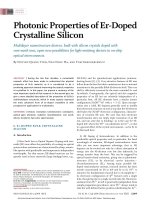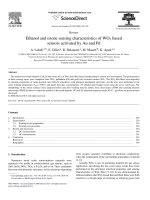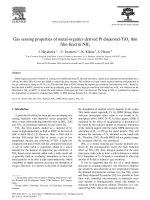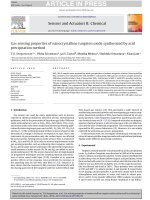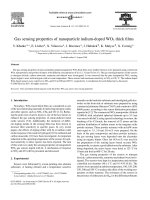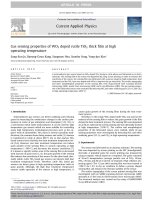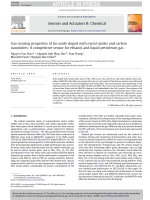- Trang chủ >>
- Khoa Học Tự Nhiên >>
- Vật lý
gas sensing properties of wo3 doped rutile tio2 thick film at high operating temperature
Bạn đang xem bản rút gọn của tài liệu. Xem và tải ngay bản đầy đủ của tài liệu tại đây (709.85 KB, 4 trang )
Gas sensing properties of WO
3
doped rutile TiO
2
thick film at high
operating temperature
Sung-Eun Jo, Byeong-Geun Kang, Sungmoo Heo, Soonho Song, Yong-Jun Kim
*
School of Mechanical Engineering, Yonsei University, Seoul 120-749, Republic of Korea
article info
Article history:
Received 31 March 2009
Received in revised form 29 June 2009
Accepted 29 June 2009
Available online xxxx
PACS:
51.50.+v
Keywords:
WO
3
doped rutile TiO
2
High temperature heat treatment
Grain growth
High temperature gas sensor
abstract
A semiconductor gas sensor based on WO
3
doped TiO
2
having a rutile phase was fabricated on an Al
2
O
3
substrate. The sensing film of the sensor was deposited by using screen printing. In order to enhance the
sensitivity of the sensor, the sensing film was fabricated with a porous shape by high temperature heat
treatment and the TiO
2
layer was doped with WO
3
to improve the gas selectivity. The surface topography
and inner morphological properties of the sensing film were characterized with scanning electron
microscopy (SEM), atomic force microscopy (AFM) and X-ray diffraction (XRD). The gas sensing proper-
ties of the fabricated sensor were evaluated by detecting NO
2
and other oxidizing gases (CO, O
2
and CO
2
)
at high operating temperature (600 ° C).
Ó 2009 Elsevier B.V. All rights reserved.
1. Introduction
Semiconductor gas sensors can detect oxidizing and reducing
gases by measuring the conductance changes in the surface phe-
nomena in terms of gas adsorption and desorption [1,2]. TiO
2
is
a well known metal oxide semiconductor. It can be used for high
temperature gas sensors which are more suitable for controlling
many high temperature technological processes such as the en-
gine’s work of automobiles. TiO
2
exists in several crystalline mod-
ifications, the common forms being anatase and rutile [3]. Anatase
is transferred to rutile at above 600 °C [4], so that anatase TiO
2
based sensors have relatively low heat treatment temperature lev-
els [5,6]. However, low heat treatment temperature can induce
grain growth of the sensing films in sensors operating at high
temperature ($500 °C) and decreases the sensors’ sensitivity [7].
It is known a specific surface area of the sensing film is decreased
with increase of grain size [1]. So, the grain growth of the sensing
film induces low sensitivity of the sensor. On the other hand, ther-
mally stable, rutile TiO
2
based gas sensors can tolerate high heat
treatment temperature levels. Therefore, rutile TiO
2
based gas
sensors can detect gases at high operating temperature with no
grain growth. Although, the high heat treatment temperature
ensures stable operation of the sensors at high temperature, it
causes grain growth of the sensing films during the heat treat-
ment process.
Therefore, in this study, WO
3
doped rutile TiO
2
was used as the
material of the sensing film to reduce the grain growth of the film
during the heat treatment process. The sensing film was deposited
on an Al
2
O
3
substrate by screen printing and was thermally treated
at high temperature (1100 °C). The surface and morphological
properties of the fabricated sensor were studied, while its gas
sensing properties were investigated by detecting NO
2
and other
oxidizing gases (CO, O
2
and CO
2
) at high operating temperature.
2. Experimental
The sensor was fabricated on an alumina substrate. The sensing
film was deposited by screen printing on the IDT (interdigitated)
electrode. A printable paste for screen printing was prepared by
using an organic vehicle based on
a
terpineol. The paste consisted
of 16 wt.% nanopowders (average particle size of TiO
2
:20nm,
WO
3
: 30 nm) and 84 wt.% solvent (
a
terpineol, ethyl cellulose, dis-
persing agent). The 1.5
l
m thick sensing film was heat treated at
1100 °C for 1.5 h in dry air condition to define a porous shaped
sensing film and enhance the thermal stability of the sensor.
The surface topography of the screen printed sensing film was
investigated with an S4800 scanning electron microscope (SEM)
operated at 15 keV and an XE150 atomic force microscope (AFM).
The structural analysis was carried out by using a D/MAX2500H
X-ray diffractometer (XRD).
1567-1739/$ - see front matter Ó 2009 Elsevier B.V. All rights reserved.
doi:10.1016/j.cap.2009.06.053
* Corresponding author. Tel.: +82 2 2123 2844.
E-mail address: (Y J. Kim).
Current Applied Physics xxx (2009) xxx–xxx
Contents lists available at ScienceDirect
Current Applied Physics
journal homepage: www.elsevier.com/locate/cap
ARTICLE IN PRESS
Please cite this article in press as: S E. Jo et al., Gas sensing properties of WO
3
doped rutile TiO
2
thick film at high operating temperature, Curr. Appl. Phys.
(2009), doi:10.1016/j.cap.2009.0 6.053
Fig. 1. SEM images of the sensing films.
Fig. 2. AFM images of the sensing films.
Fig. 3. XRD patterns of undoped TiO
2
, 11 wt.% WO
3
doped TiO
2
and 15 wt.% WO
3
doped TiO
2
.
2 S E. Jo et al. / Current Applied Physics xxx (2009) xxx–xxx
ARTICLE IN PRESS
Please cite this article in press as: S E. Jo et al., Gas sensing properties of WO
3
doped rutile Ti O
2
thick film at high operating tempe rature, Curr. Appl. Phys.
(2009), doi:10.1016/j.cap.2009.06.053
To characterize the fabricated sensor, it was used to detect NO
2
and other oxidizing gases (CO, CO
2
and O
2
). The sensor was oper-
ated at 600 °C. The ratio of the WO
3
doping into TiO
2
was varied
among 0 (undoped), 11 and 15 wt.%.
3. Results and discussion
Fig. 1 shows SEM images of the sensing films deposited by
screen printing. The sensing film exhibited the typical microstruc-
ture of screen printed sensing films. A porous sensing film surface
was obtained due to the high heat treatment temperature. The
WO
3
doping did not induce any change.
AFM micrographs of the undoped, and 11 wt.% and 15 wt.% WO
3
doped TiO
2
films are shown in Fig. 2. The AFM micrographs con-
firmed that the WO
3
doping was not a dominant factor in defining
the porous and rough surface of the sensing films.
The crystal structure of the sensing films was revealed in the
XRD patterns shown in Figs. 3 and 4. Although, the WO
3
doping ef-
fect on the surface topography was not clearly evident, the inner
morphological properties of the sensing film were affected by the
WO
3
doping. Fig. 3 revealed that the sensing films consisted of al-
most a single phase of rutile TiO
2
, while Fig. 4 revealed the (1 1 0)
peak of the rutile TiO
2
of each film. The peaks became broader and
lower with increasing amount of doped WO
3
. The grain sizes of the
sensing films were calculated by the Scherrer equation (1)
t ¼ 0:9 k=B cos h
B
: ð1Þ
In this study, we used TiO
2
nanopowder with a particle size of
20 nm. After heat treatment, the grain sizes of the undoped, and
11 wt.% and 15 wt.% WO
3
doped TiO
2
films were 102.2 nm,
68.1 nm and 62.9 nm, respectively. Following the heat treatment,
the grain sizes of the fabricated sensing films increased. But, WO
3
doping disturbed the grain growth of the sensing films. That is,
the WO
3
doping clearly affected the grain growth of the TiO
2
particles.
Fig. 5 shows the results of NO
2
(500 ppm) detection at 600 °C.
The undoped and two WO
3
doped TiO
2
sensors exhibited a gas
sensing property similar to that of a p-type, semiconductor gas
sensor. The sensitivity to gases is defined as (R
a
À R
g
)/R
g
, where
R
a
and R
g
are the steady state resistances of the device in null
(N
2
) and oxidizing gas, respectively. The two WO
3
doped TiO
2
sen-
sors had a higher sensitivity to NO
2
than that of a pure TiO
2
sensor.
Generally, the sensing film with a smaller grain size has a larger
surface area of the sensing film and higher sensitivity [1]. There-
fore, at 600 °C, the 15 wt.% WO
3
doped TiO
2
sensor had the highest
sensitivity (145.4) due to its relatively small grain size.
Due to its highest sensitivity to NO
2
, the 15 wt.% WO
3
doped
TiO
2
sensor was used to verify the selectivity by detecting three
other individual oxidizing gases, CO, O
2
and CO
2
, at 600 °C, and a
gas mixture (NO
2
+ oxidizing gases) with CO, O
2
and CO
2
concen-
trations of 1000 ppm, 15% and 10%, respectively. The detection re-
sults of the fabricated sensor for the various oxidizing gases and
the gas mixture are shown in Figs. 6 and 7.InFig. 6, sensitivities
of the sensor (15 wt.% WO
3
doped TiO
2
) to CO, O
2
and CO
2
were
very small. And in Fig. 7, the resistance of the sensor decreased
very fast in the NO
2
condition but exhibited very small changes
in the gas mixtures (NO
2
+ other oxidizing gases). These sensing re-
sults demonstrated the high sensitivity and good selectivity to NO
2
of the WO
3
doped TiO
2
sensor.
The potential energy barrier eV
S
between particles of the sensor
is proportional to N
t
,
eV
S
¼
e
2
N
t
2
e
0
e
r
N
d
ð2Þ
where N
t
is the surface density of adsorbed oxygen ions such as O
À
,
O
2À
,O
À
2
. And e
r
e
0
is the permittivity of the semiconductor, and N
d
the volumetric density of the electron donors. From Eq. (2),we
can know that the sensitivity of the sensor is dominated by the
number of adsorbed oxygen ions at the sensor surface. Because oxi-
Fig. 4. XRD patterns – (1 1 0) peak of undoped TiO
2
, 11 wt.% WO
3
doped TiO
2
and
15 wt.% WO
3
doped TiO
2
.
Fig. 5. The results of NO
2
(500 ppm) detection at 600 °C.
Fig. 6. The results of CO, O
2
and CO
2
detection at 600 °C.
S E. Jo et al. / Current Applied Physics xxx (2009) xxx–xxx
3
ARTICLE IN PRESS
Please cite this article in press as: S E. Jo et al., Gas sensing properties of WO
3
doped rutile TiO
2
thick film at high operating temperature, Curr. Appl. Phys.
(2009), doi:10.1016/j.cap.2009.0 6.053
dizing gases such as NO
2
are reacted with the oxygen species at the
sensor surface as shown in Eq. (3)
NO
2
ðgÞþO
À
2
! NO
À
2
ðadsÞ: ð3Þ
The presence of other metal oxides (WO
3
) in the lattice of the
TiO
2
film can cause a change of its electrical property and the inner
morphological properties of the TiO
2
film, which made the smaller
particle size of the sensor. It consequently affected the area of the
sensor surface which related to the number of adsorbed oxygen
ions and the gas sensing properties.
Also, we assumed that the high heat treatment temperature of
the sensor induced an electrical interaction between WO
3
and
TiO
2
, which in turn affected the electrical properties of the sensing
film. The WO
3
may occupy the interstitial sites in TiO
2
lattice
according to the following:
WO
3
!
TiO
2
W
00
Ti
þ V
00
O
þ O
x
O
ð4Þ
Since the predominant defect is an oxygen vacancy, this equilibrium
can be described by Eq. (5),
O
x
O
!
1
2
O
2
ðgÞþ2e
0
þ V
00
O
ð5Þ
where V
00
O
is the oxygen vacancy and O
x
O
is neutral oxygen in lattice.
That is, WO
3
doping induces an increase of the oxygen partial pres-
sure at the sensor surface. So, at high working temperature such as
600 °C, there is large number of adsorbed oxygen ions at the sur-
face. And it makes the high surface density of adsorbed oxygen ions
and high sensitivity to specific gas such as NO
2
.
4. Summary
AWO
3
doped TiO
2
sensor, with a sensing film deposited by
screen printing, was fabricated successfully. The use of rutile
TiO
2
as the sensing film material enabled the heat treatment to
be performed at high temperature, which facilitated the fabrication
of a sensitive and porous shaped sensing film. The WO
3
doping did
not exert a dominant effect on the surface topography but it did af-
fect the inner morphological properties of the TiO
2
film. The
15 wt.% WO
3
doped TiO
2
sensor showed the best sensitivity to
NO
2
at 600 °C. The proposed sensor had good sensitivity and selec-
tivity to NO
2
, in comparison with its sensitivity to other oxidizing
gases such as CO, O
2
, and CO
2
.
Acknowledgements
This work was supported in part by the Information Technology
Research Center support program (IITA-2005-C1090-0592-0012),
and in part by Korea Science and Engineering Foundation (KOSEF)
Grant funded by the Korea government (MEST) (2008-8-1253).
References
[1] G. Korotcenkov, Materials Science and Engineering B 139 (2007) 1–23.
[2] C.O. Park, S.A. Akbar, Journal of Materials Science 38 (2003)
4611–4637.
[3] L. Francioso, D.S. Presicce, M. Epifani, P. Siciliano, A. Ficarella, Sensors and
Actuators B 107 (2005) 563–571.
[4] S.J. Kim, G.H. Chang, Y.C. Jin, G.R. Jheong, Journal of the Korean Society for Heat
Treatment 7 (1) (1994) 11–16.
[5] Ken-ichi Shimizu, Kohichi Kashiwagi, Hiroyuki Nishiyama, Shiro Kakimoto,
Satoshi Sugaya, Hitoshi Yokoi, Atsushi Satsuma, Sensors and Actuators B 130
(2008) 707–712.
[6] A. Wisitsoraat, E. Comini, G. Sberveglieri, W. Wlodarski, A. Tuantranont, in: The
2nd IEEE International Conference on Nano/Micro Engineered and Molecular
Systems, 16–19th January 2007, Bangkok, Thailand.
[7] S.S. Bhoga, K. Singh, Ionics 13 (2007) 417–427.
Fig. 7. The results of gas mixture detection at 600 °C.
4 S E. Jo et al. / Current Applied Physics xxx (2009) xxx–xxx
ARTICLE IN PRESS
Please cite this article in press as: S E. Jo et al., Gas sensing properties of WO
3
doped rutile Ti O
2
thick film at high operating tempe rature, Curr. Appl. Phys.
(2009), doi:10.1016/j.cap.2009.06.053
